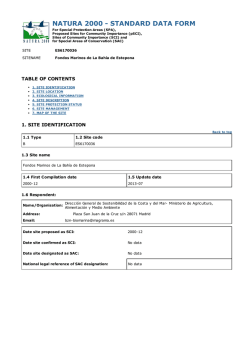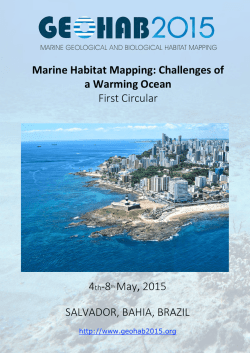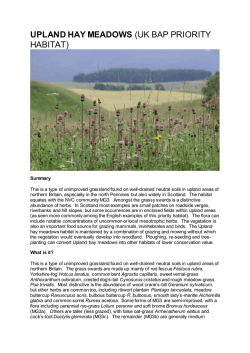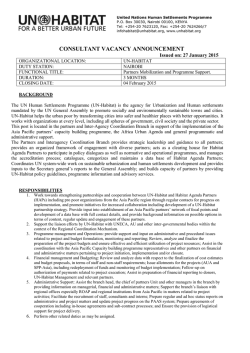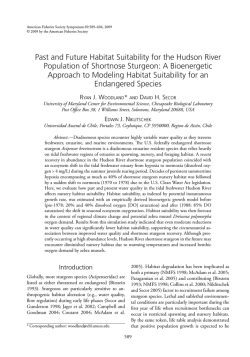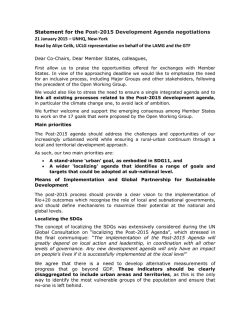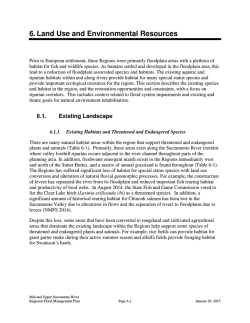
(FAQ) on Habitat III - Communitas Coalition
! Frequently Asked Questions (FAQ) on Habitat III! Prepared by the Communitas Coalition! Last updated: 29th January 2015! ! ! Frequently Asked Questions on Habitat III! Q: What is Communitas?! Q: What is Habitat III?! Q: What is the preparatory process for Habitat III?! Q: What were Habitats I and II?! Q: What has been the progress made since Habitat II in 1996?! Q: What is link between Habitat III in 2016 and the UN's Post-2015 Development & Climate Agendas?! Q: What are Communitas' key contributions to Habitat III?! Q: What is Communitas?! Communitas is the Coalition for Sustainable Cities & Regions in the New UN Development Agenda. It is led by its core partners - Tellus Institute, ICLEI- Local Governments for Sustainability, nrg4SD- Network of Regional Governments for Sustainable Development and UN-Habitat - with the support of the Ford Foundation.! Communitas aims to establish a participatory process:! - To advance sustainable urbanization as a key component of the future UN Post 2015 Development Agenda, its goals, targets, means of implementation and partnerships;! - To contribute to the technical development of a Sustainable Development Goal (SDG) with targets related to the economic, social, environmental, spatial and cultural dimensions of sustainable urbanization and a basket of relevant indicators;! - To ensure the presence, as appropriate, of an urban dimension across the final set of SDGs to be agreed upon;! - To link the process for the elaboration and adoption of the UN SDGs with the UN Habitat III Conference in 2016.! In this context, Communitas is a two-fold platform supporting the UN intergovernmental process for establishing the SDGs and connecting it to the UN Habitat III Conference. On the one hand, it provides expert and practitioner-led task technical input into the UN intergovernmental processes. On the other hand, it also facilitates a broad multi-stakeholder coalition of organizations keen on advancing sustainable urbanization as a key component of the Post-2015 UN Development Agenda, particularly in the horizon of Habitat III in 2016.! Q: What is Habitat III?! Habitat III is the United Nations Conference on Housing & Sustainable Urban Development to take place 17-21 October 2016 in Quito, Ecuador. The conference will feature six plenary sessions, six roundtables and a series of thematic panels. Habitat III will produce a 'New Urban Agenda' for the 21st century, in which more than half of the world’s population lives in cities, with 70% expected by 2050. Although they occupy just 3% of the world’s land area, cities currently account for 75% of global energy consumption and 80% of global carbon emissions. Cities are home to almost one billion slum dwellers, who are especially exposed to pollution, congestion, vulnerability to disaster and inadequate services. ! 1 Q: What is the preparatory process for Habitat III?! There are three scheduled meetings of the Preparatory Committee (PrepCom) for Habitat III:! - PrepCom1: 17-18th September 2014, United Nations Headquarters, New York, USA! - PrepCom2: 14-16th April 2015, UN Gigiri, Nairobi, Kenya! - PrepCom3: July 2016, TBC, Indonesia! The 1st Meeting of the Preparatory Committee in New York decided to adopt the rules of procedure of the ECOSOC functional commission for Habitat III Prepcoms, thus enabling NGOs with ECOSOC status to participate in the Preparatory Process. The rules of procedure and special accreditation for non-ECOSOC NGOs for the Habitat III Conference in 2016 were deferred to discussions at the 2nd Prepcom. It also appointed a Habitat III Bureau to collaborate with the Habitat III Secretariat on conference preparations:! Co-chairs: ! ! H.E. Mr. Diego Aulestia Valencia, Ecuador! ! H.E. Ms. Maryse Gautier, France! Members:! !Africa: Senegal and Chad;! !Asia: UAE and Indonesia; ! !Eastern Europe: Czech Republic and Hungary;! !Latin America: Chile and Ecuador;! !Western Group: France and Germany! Habitat III Secretary-General Dr. Joan Clos expressed support for "proposals by several countries to organise regional events in preparation of Habitat III...[in addition to proposals for] several meetings on specific topics. Five of them have already been proposed...Urban-Rural Linkages, Housing, Urban Mobility, Municipal Finance, and Gender Participation. Those issues as sectoral aspects of the preparation will be elaborated further by the Secretariat and proposed to the Bureau in order to organise them as a consultative process on the way to Habitat III" (http://bit.ly/h3prepclosing). ! A Zero Draft of the New Urban Agenda is expected by April 2016, following the parallel completion of negotiations around the UN Post-2015 Development Agenda & Sustainable Development Goals and the Climate Action Framework.! Habitat III will feature six thematic areas, commissioning a total of 20 short issue papers:! 1. Social Cohesion and Equity- Livable Cities! A. Inclusive cities (a.o. Pro-poor, Gender, Youth, Ageing)! B. Migration and refugees in urban areas! C. Safer Cities! D. Urban Culture and Heritage! 2. Urban Frameworks! E. Urban Rules and Legislation! F. Urban Governance! 2 G. Municipal Finance! 3. Spatial Development! H. Urban and Spatial Planning and Design! I. Urban Land! J. Rural-urban linkages! 4. Urban Economy! K. Local Economic Development! L. Jobs and Livelihoods! M. Informal Sector! 5. Urban Ecology and Environment! N. Urban Resilience! O. Urban Ecosystems and Resource Management! P. Cities and Climate Change and Disaster Risk Management! 6. Urban Housing and Basic Services! Q. Urban Infrastructure and Basic Services, including energy! R. Transport and Mobility! S. Housing and Slum Upgrading! T. Smart Cities! Q: What were Habitats I and II?! The conference has been held every 20 years beginning with Habitat I in Vancouver, 1976 and Habitat II in Istanbul, 1996. The chief outcome of Habitat I was the Vancouver Declaration on Human Settlements (http://habitat.igc.org/vancouver/van-decl.htm), comprised of an action plan with 64 recommendations for national action. It also led to the United Nations Centre for Human Settlements (UNCHS), which would ultimately become UN-Habitat, the official UN agency for cities & human settlements.! Habitat II, convened twenty years later in Istanbul, provided a new mandate for the UNCHS. Its chief outcomes were the Istanbul Declaration on Human Settlements (http://ww2.unhabitat.org/ declarations/ist-dec.htm) and the corresponding Habitat Agenda (http://ww2.unhabitat.org/ declarations/habitat_agenda.asp), adopted jointly as a new global action plan to realise sustainable human settlements.! Q: What has been the progress made since Habitat II in 1996?! In his Report to the General Assembly in July 2014 (http://unhabitat.org/wp-content/uploads/ 2014/07/Progress-to-date-outcome-Habitat-II-ENGLISH1.pdf), Habitat III Secretary-General Dr. Joan Clos reported, "Urbanization has brought growth and development...[but] has been unable to respond to many existing and emerging challenges such as: urban sprawl, congestion, pollution, emission of greenhouse gases, emerging urban poverty, segregation, increasing inequalities and other negative externalities." He further expounded on this statement in his address to the 1st Preparatory Committee for Habitat III (http://unhabitat.org/wp-content/ 3 uploads/2014/07/Dr.-Clos-Statement-Conference-Progress-Report-and-Habitat-AgendaImplementation.pdf), calling upon member states to continue mobilising their National Habitat Committees to prepare their national reports for Habitat III by the end of 2014. In turn, these will inform the regional reports prepared by UN Economic Commissions in collaboration with the Habitat III Secretariat. In his address, Dr. Clos highlighted six new challenges and issues that have emerged since 1996:! 1. Cities now represent more than half of the world’s population;! 2. Urban expansion in many developing countries has often been characterized by informality, illegality and unplanned settlements... At the core of this problem is lack of protection of the public space, and availability of accessible buildable plots;! 3. While high population growth remains a concern in the least developed countries, countries in many other parts of the world are grappling with slower population growth or even population decline... In developing regions, many countries are experiencing a significant increase in the proportion in young people;! 4. Inequality has become a universal concern. Differences in access to opportunity, income, consumption, location,information and technology are now the norm, not the exception... Slums...continue to grow in most developing countries, reinforcing other forms of inequality;! 5. An increasing number of urban residents in developed countries experience poverty or social exclusion;! 6. Cities are responsible for as much as 70 % of the world’s carbon emissions. A well planned and managed urbanization is a prerequisite for reduction in carbon emissions and for increased resilience to climate related disasters. ! Q: What is link between Habitat III in 2016 and the UN's Post-2015 Development and Climate Agendas?! As noted by the International Institute for Sustainable Development (http://sd.iisd.org/news/ habitat-iii-prepcom-recognizes-urbanization-as-key-to-sustainable-development/), "Habitat III will be the first UN global summit to take place following the adoption of the post-2015 agenda and the anticipated adoption of a new climate agreement. It is expected to bring together governments, local authorities, civil society, the private sector, academia and others to review urban and housing policies and f." Therefore, it has the unique potential to at once catalyse local implementation of the UN Post-2015 Development Agenda & Sustainable Development Goals (September 2015) and the Climate Action Framework (December 2015).! The UN SDGs Open Working Group (SDGs OWG) was tasked in January 2013 with proposing an aspirational set of goals and targets to the UN General Assembly by September 2014. After holding thirteen sessions between March 2013 and July 2014, the SDGs Open Working Group (co-chaired by H.E. Mr. Csaba Kõrösi, Permanent Representative of Hungary, and H.E. Mr. Macharia Kamau, Permanent Representative of Kenya) approved by consensus a total of 17 goals and 169 targets. The full report is available at:! 4 http://sustainabledevelopment.un.org/content/documents/4518SDGs_FINAL_Proposal%20of %20OWG_19%20July%20at%201320hrsver3.pdf! 1. End poverty in all its forms everywhere! 2. End hunger, achieve food security and improved nutrition, and promote sustainable agriculture! 3. Ensure healthy lives and promote well-being for all at all ages! 4. Ensure inclusive and equitable quality education and promote life-long learning opportunities for all! 5. Achieve gender equality and empower all women and girls! 6. Ensure availability and sustainable management of water and sanitation for all! 7. Ensure access to affordable, reliable, sustainable, and modern energy for all! 8. Promote sustained, inclusive and sustainable economic growth, full and productive employment and decent work for all! 9. Build resilient infrastructure, promote inclusive and sustainable industrialization and foster innovation! 10. Reduce inequality within and among countries! 11. Make cities and human settlements inclusive, safe, resilient and sustainable! 12. Ensure sustainable consumption and production patterns! 13. Take urgent action to combat climate change and its impacts! 14. Conserve and sustainably use the oceans, seas and marine resources for sustainable development! 15. Protect, restore and promote sustainable use of terrestrial ecosystems, sustainably manage forests, combat desertification, and halt and reverse land degradation and halt biodiversity loss! 16. Promote peaceful and inclusive societies for sustainable development, provide access to justice for all and build effective, accountable and inclusive institutions at all levels! 17. Strengthen the means of implementation and revitalize the global partnership for sustainable development! For a complete analysis of targets under SDG 11- Sustainable Cities & Human Settlements, please visit: http://communitascoalition.org/owg_concludes.html.! The current session of the UN General Assembly will resume SDG negotiations within its traditional member-state system of representation. This marks a change from the 30 memberstates, 70 seats format of the Open Working Group to the wider 191 member-states, 191 seats General Assembly. Negotiations will be based on the Secretary-General’s Report in November 2014, culminating in a MDGs-SDGs Summit in September 2015.! Following the Secretary-General's Climate Summit on 23rd September, member-states are also preparing for the 20th Conference of the Parties (COP 20) to the 1992 United Nations Framework Convention on Climate Change (UNFCCC). While COP 20 will soon be held in Lima in December 2014, COP 21 in Paris will aim to achieve, for the first time in over 20 years, a binding and universal agreement on climate by and for the international community.! ! 5 Q: What are Communitas' key contributions to Habitat III?! Communitas is focusing its activities towards Habitat III around three areas:! 1. Connecting the SDGs and the Habitat III process by technically unpacking proposed targets into indicators relevant to the subnational and local levels and toolkits for implementation;! 2. Facilitating a series of multi-stakeholder dialogues on Rural-Urban Synergies;! 3. Collaborating with the World Urban Campaign on stakeholder engagement.! The following is a brief outline of Communitas inputs to Habitat III.! For a complete Interim Report of Activities detailing the Coalition's prior work, please visit:! http://communitascoalition.org/pdf/interim_report.pdf! SUSTAINABLE DEVELOPMENT GOALS (SDGs) AND HABITAT III! Communitas Side Event, "From MDG to SDG: Towards a New Paradigm at Habitat III" at 1st Habitat III Preparatory Committee, New York City (18th September 2014);! Communitas Side Event, "Urban Sustainability at the Core of Human Development" at 1st Post 2015 Negotiation Session, New York City (20th January 2015);! Communitas' Indicator Work to build on intergovernmental, multi-stakeholder excercises on SDG targets. The Communitas Coalition is collaborating with civil society, national, local, subnational governments, and UN agencies to identify a relevant basket of indicators for an SDG Cities & Human Settlements. This has been key to ongoing discussions around a data revolution for sustainable development, including bottom-up tools and methods for grassroots data collection on the ground (ongoing thru September 2015);! Communitas Pilot Projects to fast track the implementation of an SDG on Cities & Human Settlements and its targets by testing indicators and methodologies. The pilots will leave a legacy of new partnerships as well as of SDGs implementation at the city-region level (2015).! RURAL-URBAN SYNERGIES AND HABITAT III! Habitat III Orientation Session at which Communitas led a breakout group on rural-urban synergies, 1st Habitat III Preparatory Committee, NYC (16th September 2014);! Communitas Dialogues on Rural Urban Synergies at the UN Habitat Governing Council & 2nd Habitat III Preparatory Committee, Nairobi (April 2015);! Technical inputs to the Habitat III Spatial Development Issue Paper on "Rural-Urban Linkages" (thru mid-2016).! WORLD URBAN CAMPAIGN AND HABITAT III! Stakeholder Engagement. Communitas is providing technical support to the World Urban Campaign in its mobilisation and organisation of major groups and other stakeholders during the run-up to Habitat III (thru October 2016);! Rural-Urban Thematic Inputs. Communitas is leading rural-urban discussions within the World Urban Campaign to produce thematic inputs to the New Urban Agenda (thru Oct 2016). 6
© Copyright 2025
